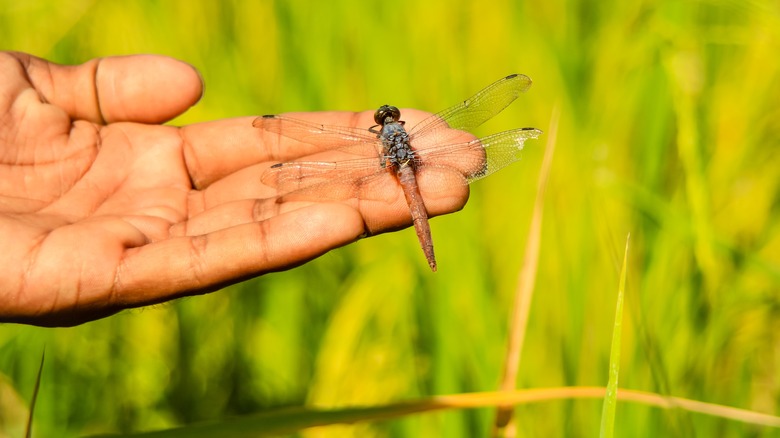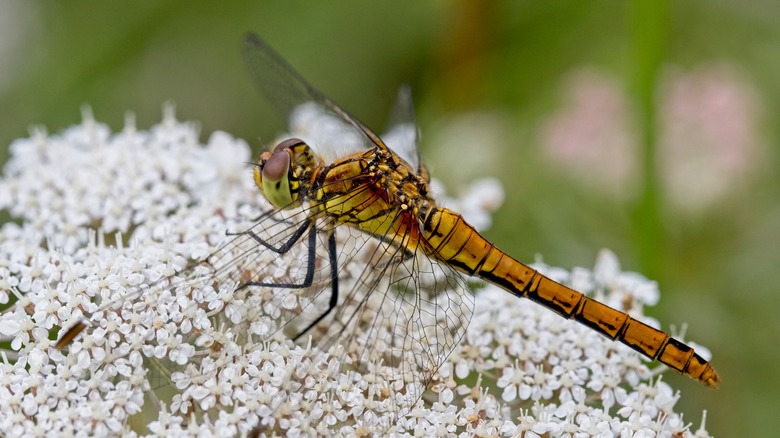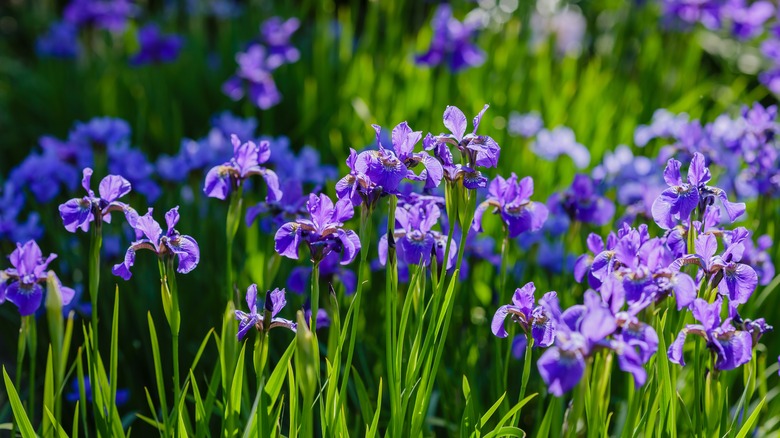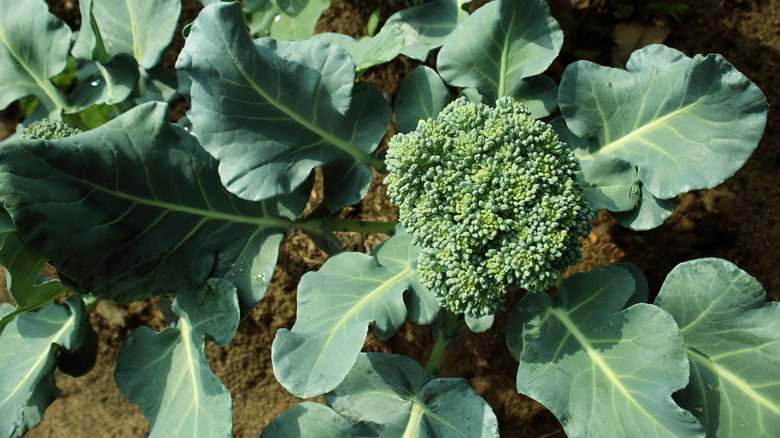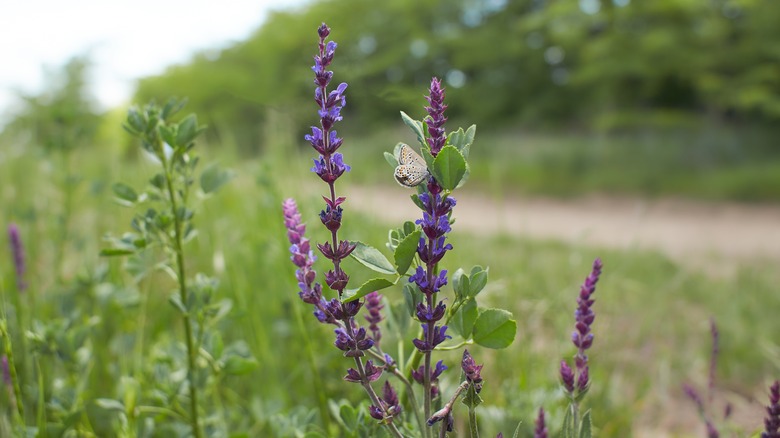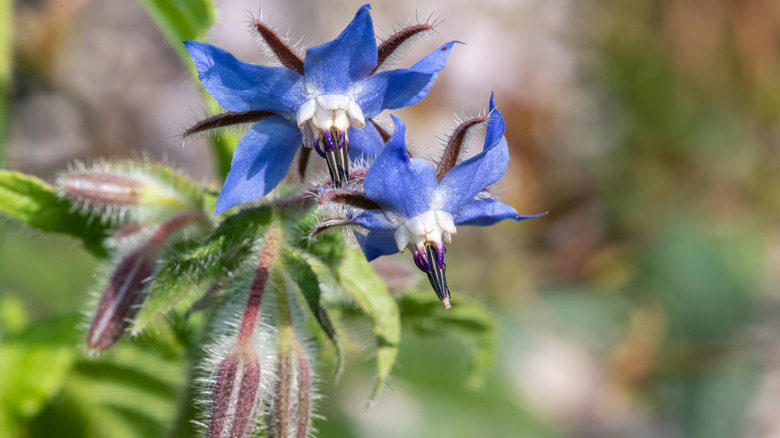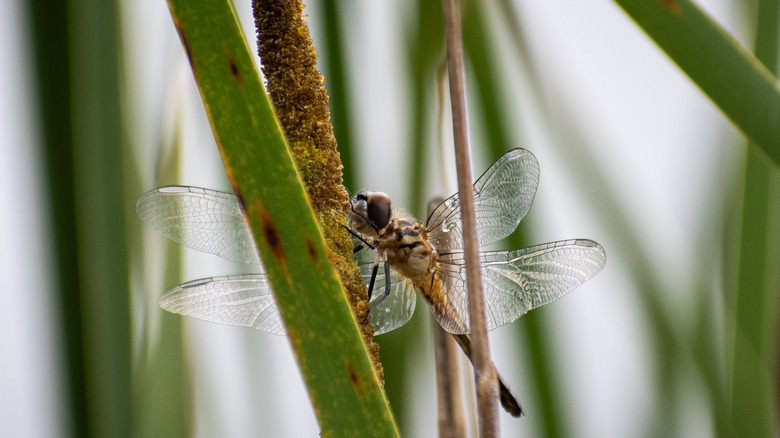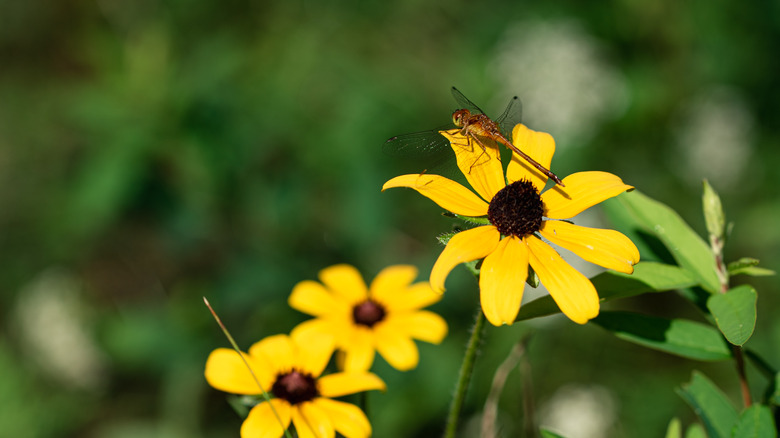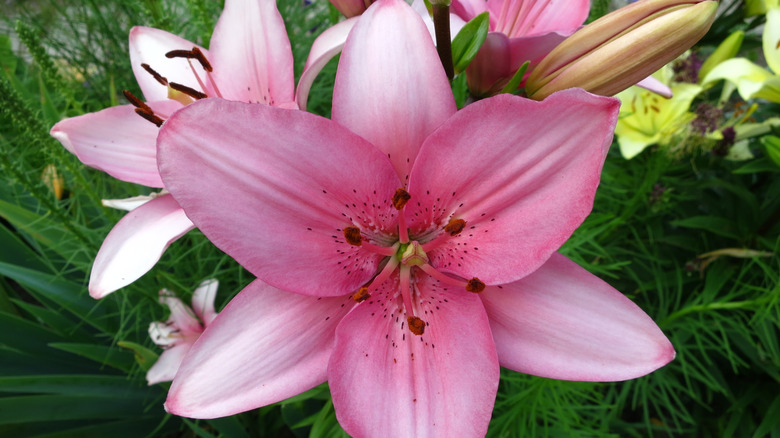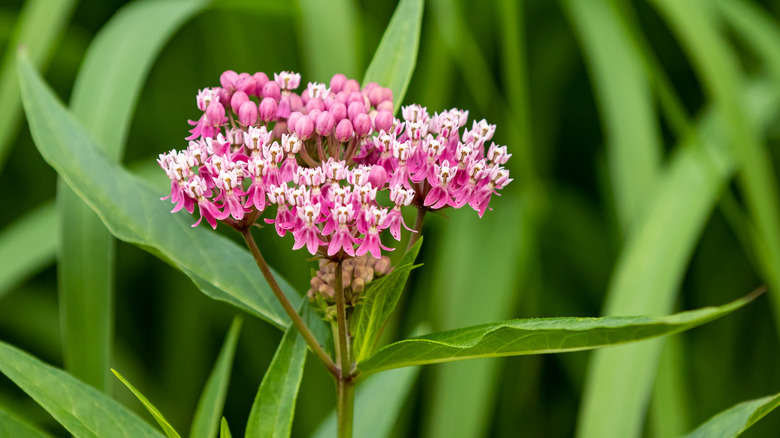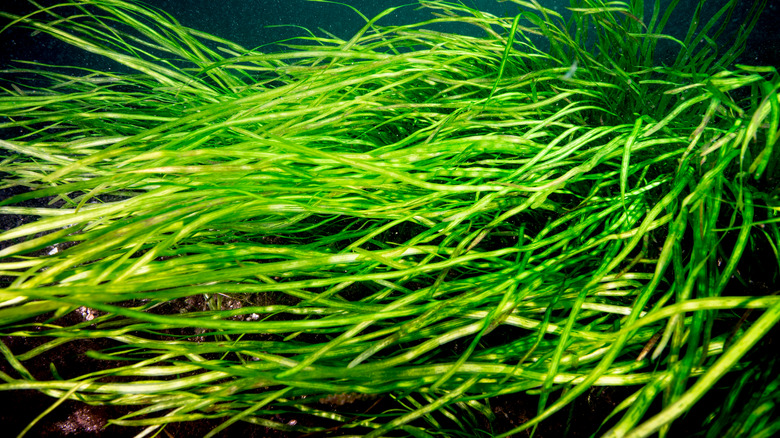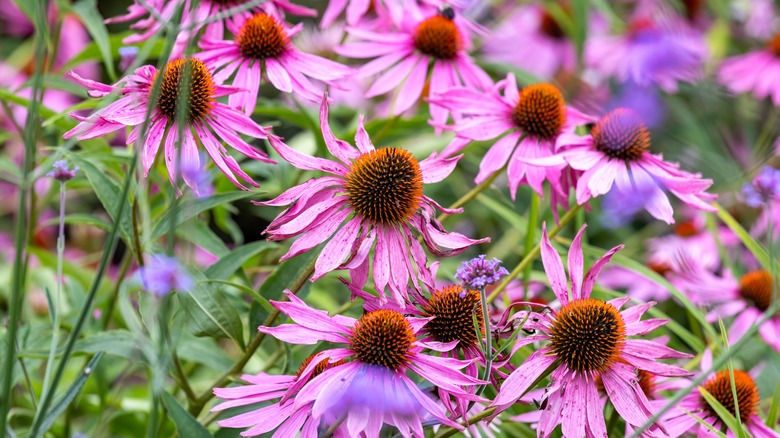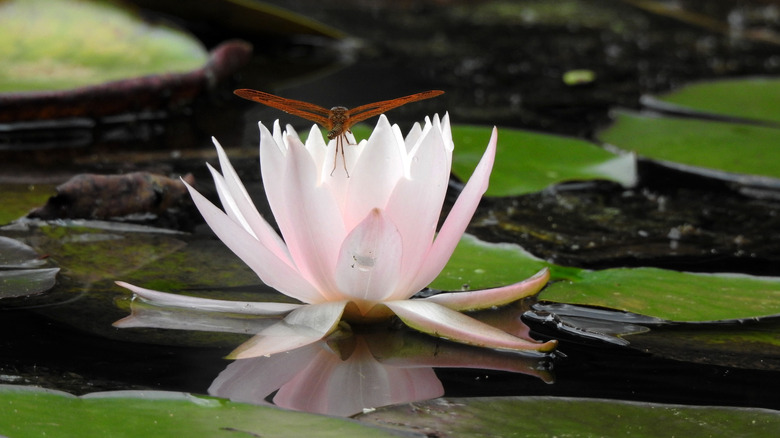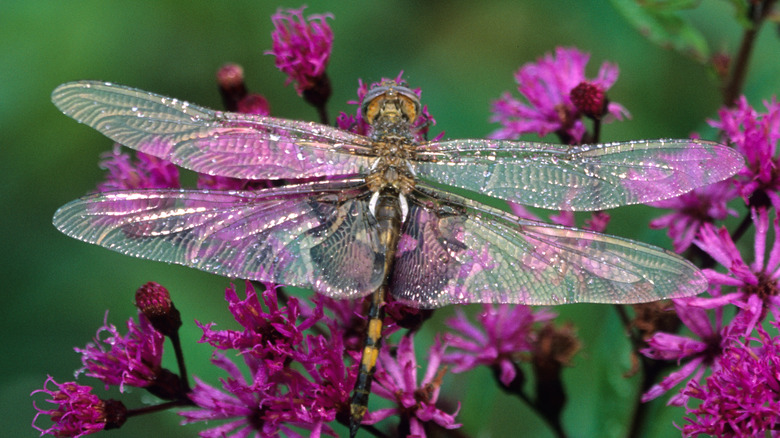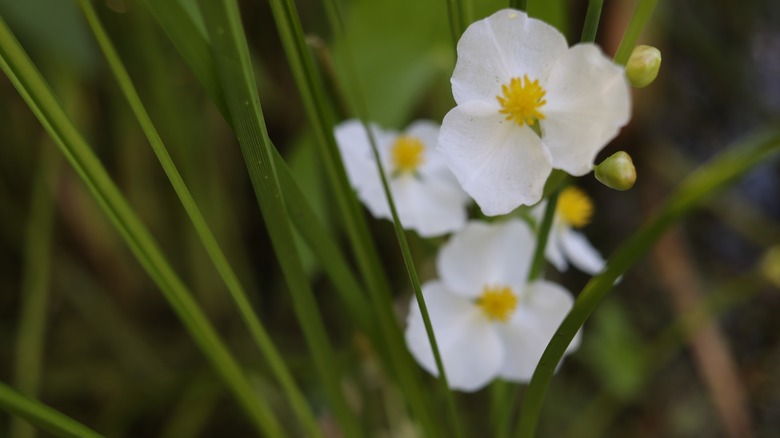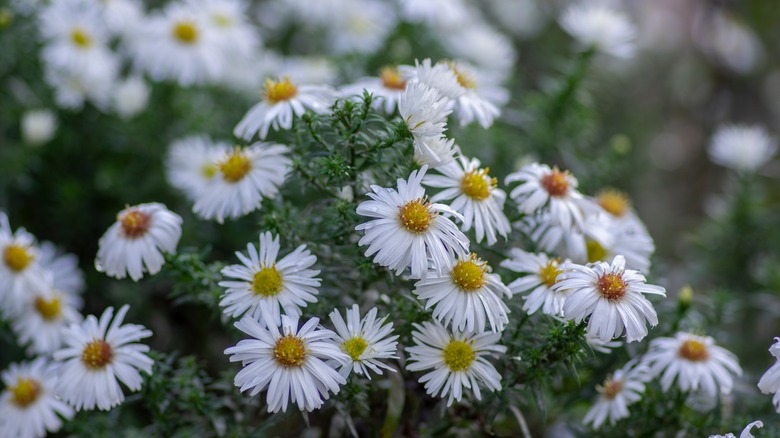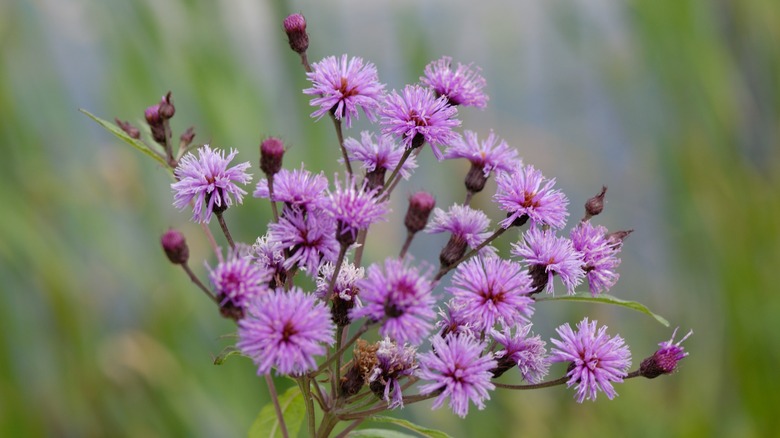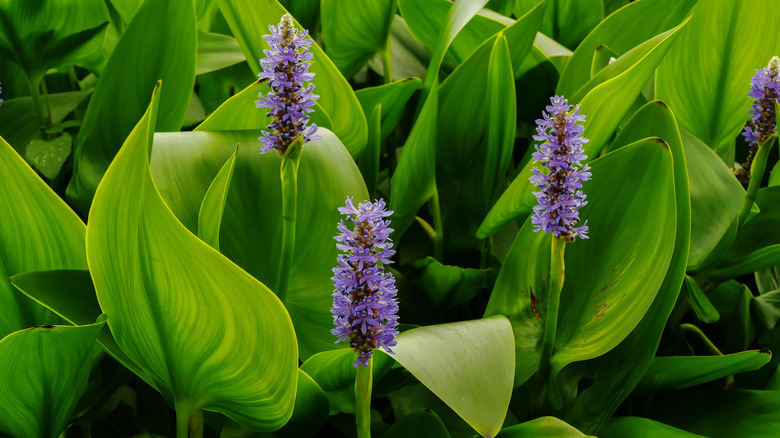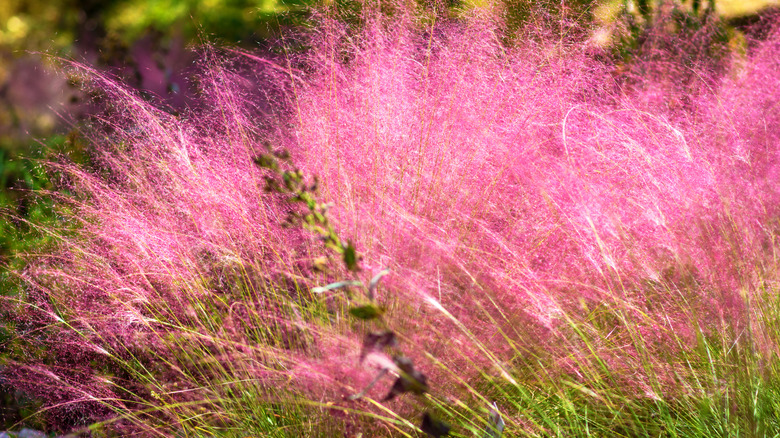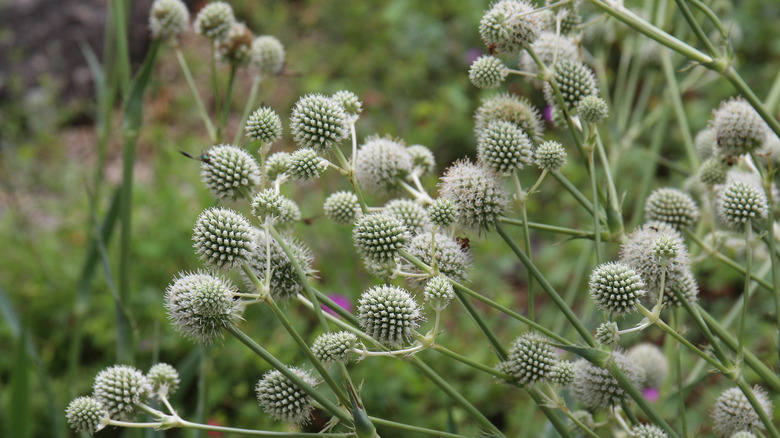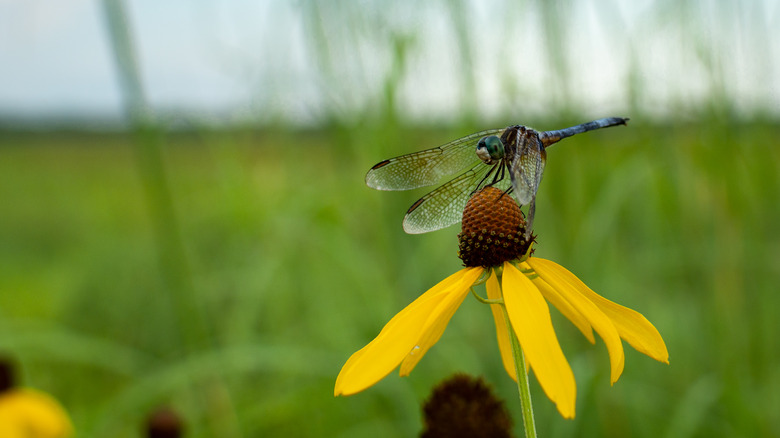Plants That Will Attract Dazzling Dragonflies To Your Garden
Dragonflies are beloved for their unique bodies, unmatched flying skills, and glistening colors. Today, there are more than 5,000 known species of dragonflies that zip around ponds and lakes all over the world. Whether you're a newbie to attracting and watching dragonflies or a seasoned chaser, it's never too late to learn about the plants you can grow at home to invite more of these delightful creatures to your yard.
One thing to consider first, however, is the other insects that are already using your garden for food. Dragonflies are carnivorous predators and they've been known to consume pollinators as well as beneficial insects. They will not differentiate between helpful and destructive bugs in your garden, so while they do like mosquitoes and gnats, they'll also snack on butterflies and bees when they get the chance. As you peruse this list of plants that entice dragonflies, think about your garden's existing ecosystem, the plants it can support, and other things dragonflies like such as water features. Doing this before planting will ensure that your garden turns into a dragonfly paradise with just a bit of effort.
1. Yarrow
Yarrow plants (Achillea spp.) are known for appealing to beneficial insects such as bees, butterflies, and parasitic wasps. However, those aren't the only bugs that love the plant. Dragonflies also enjoy eating the pollinators that eat yarrow's pollen, and they are specifically attracted to the flat clusters of flowers that act like a landing pad for them.
Bloom Season: Mid-spring to early fall
USDA Growing Zone: 4 to 8
Growing Conditions: Full sun to partial shade
Soil Type: Nutrient-poor and dry
Size: 2 to 3 feet tall and 1 foot wide
2. Siberian iris
Siberian irises (Iris sibirica), which grow best in rain gardens, around ponds, or near water features, are a must-plant if you are trying to draw dragonflies to your yard. Dragonflies already like to be near water to raise their aquatic babies, so it only makes sense to plant flowers like this that enjoy being near the water too.
Bloom Season: Spring and summer
USDA Growing Zone: 4 to 9
Growing Conditions: Full sun
Soil Type: Rich and well-draining
Size: Up to 2 feet tall
3. Broccoli
Broccoli (Brassica oleracea) may be a surprising addition to this list, but it makes a lot of sense for attracting dragonflies if you want to deter them from snacking on important pollinators. Broccoli does not need pollination to grow, but they are affected by aphids and white caterpillars that eat their foliage. These also lure in hungry dragonflies which will in turn protect your broccoli from pests.
Bloom Season: Spring
USDA Growing Zone: 6 to 9
Growing Conditions: Full sun to partial shade
Soil Type: Moist and well-draining
Size: Up to 2 feet tall and wide
4. Meadow sage
Meadow sage (Salvia nemorosa) blooms in the summer bringing out a range of animals and insects that enjoy the pollen it produces as well as the taste of its flowers and foliage. Most often, meadow sage attracts butterflies and bees, and the presence of pollinators also brings the carnivorous dragonflies searching for a meal.
Bloom Season: Summer
USDA Growing Zone: 3 to 8
Growing Conditions: Full sun
Soil Type: Well-draining clay or sand
Size: 8 to 12 inches tall and 12 inches wide
5. Borage
Borage (Borago officinalis) is an edible flower typically used in salads and drinks, or as a garnish for other dishes. It can be identified by its roughly textured green leaves and bright blue flowers. In some parts of North America, this plant is considered invasive, so you should be careful where you plant it.
Bloom Season: Spring and summer
USDA Growing Zone: 2 to 11
Growing Conditions: Full sun to partial shade
Soil Type: Well-draining and sandy
Size: 3 feet tall
6. Cattails
Cattails (Typha latifolia) require wet soil and lots of access to water, so they're a great option for a garden with a pond, large water feature, or stream running through it. Because they share the same habitat with dragonflies and provide them with shelter, the brilliantly winged insects are easily beckoned to a grove of cattails.
Bloom Season: Summer
USDA Growing Zone: 3 to 10
Growing Conditions: Full sun to partial shade
Soil Type: Wet and loamy
Size: 4 to 6 feet tall and wide
7. Black-eyed Susan
Black-eyed Susans (Rudbeckia hirta) are a popular choice for gardeners looking to invite dragonflies to their yards. The flowers offer a landing pad for dragonflies as well as a place to drink as they rest their wings. Black-eyed Susans are also very easy to grow, so you'll have no problem raising a bunch of them for these large insects to hangout on.
Bloom Season: Summer to fall
USDA Growing Zone: 3 to 10
Growing Conditions: Full sun to partial shade
Soil Type: Well-drained clay, loam, or sand
Size: 1 to 3 feet tall
8. Asiatic lilies
Asiatic lilies (Lilium spp.) are known for their gorgeous blossoms that can feature many different colors and patterns depending on the cultivar you choose. They usually bloom in the middle of summer and their flowers can reach up to 6 inches in diameter. The giant blossoms easily attract beautiful pollinators like butterflies as well as other fascinating insects such as dragonflies.
Bloom Season: Summer
USDA Growing Zone: 4 to 8
Growing Conditions: Full sun
Soil Type: Average and consistently moist
Size: 24 to 36 inches tall
9. Swamp milkweed
Native to wet meadows and swamps, swamp milkweed (Asclepias incarnata) is among the best plants to appeal to your favorite fliers. Milkweed is a food source and larval host for some butterfly species, which are eaten by dragonflies. Additionally, the wet environment where it grows is also attractive to mosquitos that are eaten by the predatory bugs as well.
Bloom Season: Summer
USDA Growing Zone: 3 to 6
Growing Conditions: Full sun
Soil Type: Average medium to wet soil
Size: 3 to 4 feet tall and 2 to 3 feet wide
10. Wild celery
Wild celery (Vallisneria americana), also known as tape-grass, American eelgrass, and water celery, is an important plant for insects and wildlife that live around shallow water that has sandy or mucky soil beneath it. Wild celery is an especially good option for dragonflies because it shelters their aquatic babies who hide in the foliage and eventually climb the plant when they're ready to fly.
Bloom Season: Summer
USDA Growing Zone: 4 to 10
Growing Conditions: Full sun to partial shade
Soil Type: Grows in water
Size: Up to 6 feet tall
11. Purple coneflower
The purple coneflower (Echinacea purpurea) is a long-blooming and especially popular garden plant favored for its low-maintenance habit and pretty flowers. These coneflowers are also known for their drought tolerance and ability to keep deer at bay. In the summer, the plant draws butterflies and other pollinators with its dependable nectar sources.
Bloom Season: Mid-summer to late fall
USDA Growing Zone: 3 to 9
Growing Conditions: Full sun to partial shade
Soil Type: Evenly moist and well-draining
Size: 4 feet tall and 2 feet wide
12. American white waterlily
The American white waterlily (Nymphaea odorata) might be the first plant you think of when you consider what dragonflies are attracted to. Its large flowers and floating foliage allow the insects to rest, drink, and feed before flying over large or small bodies of water. Keep in mind, these plants bring more than dragonflies; they are also loved by bees, turtles, and birds.
Bloom Season: Summer to early fall
USDA Growing Zone: 4 to 11
Growing Conditions: Full sun
Soil Type: Standing water or moist and mucky soil
Size: 2 to 20 feet long
13. Joe-Pye weed
Joe-Pye weed (Eutrochium maculatum), also known as queen of the meadow, is a wildflower that can be planted in wet areas. Its clusters of small pink to white flowers blossom in the summer and stay until the end of fall. They are a food source for bees and butterflies, and are a great addition to a native, pollinator, or rain garden.
Bloom Season: Summer and fall
USDA Growing Zone: 3 to 8
Growing Conditions: Full sun to partial shade
Soil Type: Average wet or moist
Size: 4 to 7 feet tall and 3 to 4 feet wide
14. Broadleaf arrowhead
Broadleaf arrowhead (Sagittaria latifolia), which is native to the wet areas of eastern and central North America, is best described as a vigorously-growing aquatic herbaceous perennial that produces edible tubers. This plant normally grows partially submerged underwater, so it is often sought out by dragonflies and nymphs who use it for shelter.
Bloom Season: Summer
USDA Growing Zone: 5 to 10
Growing Conditions: Full sun
Soil Type: Grows in water
Size: 1 to 4 feet tall and 1 to 3 feet wide
15. New York aster
New York aster (Symphyotrichum novi-belgii) is a daisy-like plant that shows off purple or white petals and a yellow center in the fall. It always grows near a water source so you may find it around marshes and shores. Unsurprisingly, the flowers attract pollinators as they bloom, however, you might not know that it is a host plant for the pearl crescent butterfly.
Bloom Season: Fall
USDA Growing Zone: 4 to 8
Growing Conditions: Full sun to partial shade
Soil Type: Well-draining and consistently moist
Size: 3 to 5 feet tall and 1 to 2 feet wide
16. Ironweed
Ironweed plants (Vernonia fasciculata) are named for their sturdy stems and aggressive spreading, so not everyone realizes how beautiful their flowers are. Ironweed produces bright clusters of purple flowers blooming through July, August, and September. They normally tower over other flowers, so they are immediately alluring to lots of insects, including dragonflies.
Bloom Season: Late summer
USDA Growing Zone: 3 to 7
Growing Conditions: Full sun
Soil Type: Average and moist
Size: 4 to 6 feet tall
17. Pickerel weed
Pickerel weed (Pontederia cordata) is an herbaceous perennial that is grown as a water plant in ponds and other shallow water features. It flowers from June to October as it shows off light blue flower spikes above glossy green foliage on which dragonflies often lay their eggs.
Bloom Season: Summer to fall
USDA Growing Zone: 3 to 10
Growing Conditions: Full sun
Soil Type: Rich, wet organic loam
Size: 2 to 4 feet tall and 2 feet wide
18. Muhly grass
Muhly grass (Muhlenbergia capillaris) is a species of ornamental grass that produces pink and green foliage. It grows well in dry climates with warm weather, however, it is known to grow in a variety of environments that offer different types of sunlight, water, and soil. Per Clemson Cooperative Extension, muhly grass makes a good addition to a rain garden.
Bloom Season: Fall
USDA Growing Zone: 5 to 11
Growing Conditions: Full sun to partial shade
Soil Type: Well-draining sand or gravel
Size: 2 to 3 feet tall and wide
19. Rattlesnake master
Rattlesnake master (Eryngium yuccifolium) is named for its use by Native Americans who relied on the root to remedy rattlesnake bites. Now we know this is a misconception, but it is true that the plant was used medicinally in the past. Today, the rattlesnake master is grown ornamentally for its golf ball-like flowers that attract bees, flies, wasps, and butterflies along with dragonflies.
Bloom Season: Summer
USDA Growing Zone: 3 to 8
Growing Conditions: Full sun
Soil Type: Average garden or sandy soil
Size: 3 feet tall and 2 to 3 feet wide
20. Yellow coneflower
The yellow coneflower (Echinacea paradoxa) is related to the purple coneflower and the narrow-leaved coneflower, although it does not produce purple petals. The flowers, which are sometimes 6 inches across, are delightfully fragrant and favored by butterflies, bees, and other insects. Like other species of Echinacea, this coneflower is easily grown, low-maintenance, and tolerant of neglect.
Bloom Season: Early summer
USDA Growing Zone: 3 to 9
Growing Conditions: Full sun
Soil Type: Humus-rich and well-draining
Size: 18 to 36 inches tall
